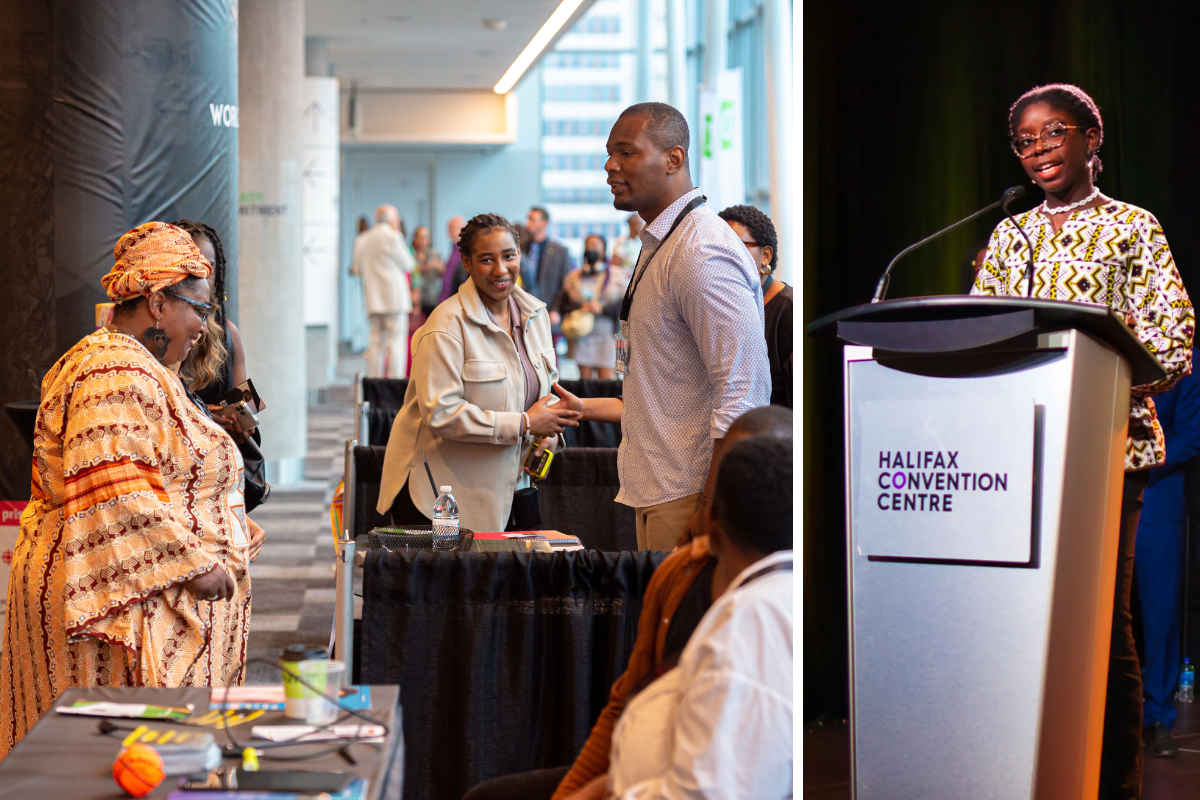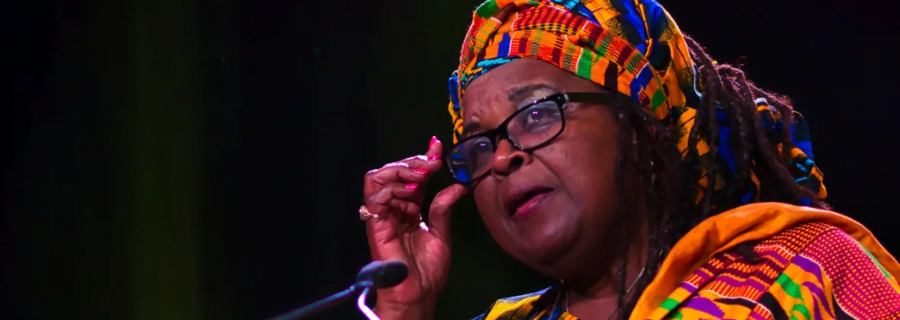Above: Dr. Lynn Jones reads the Halifax Declaration and the actions needed to improve the lives of Black Canadians and people of African descent (Alvero Wiggins photo).
Last year, Halifax hosted the National Black Canadians Summit. What comes next?
In July 2022, Halifax welcomed the National Black Canadians Summit, and the success of the event cannot be overstated. Hosted by the Michaëlle Jean Foundation, the summit drew over 1,000 attendees from all over Canada and, according to a report issued by Discover Halifax, contributed $1.1 million to the local economy.
Halifax was initially planned to be the third and final host city for the summit, but COVID-19 moved Halifax to the forefront of the discussion for the summit’s second year. “The 2022 summit was two years in the making,” says Symonds. “Immediately after the 2019 summit, there were groups of African Nova Scotians saying it had to be in Halifax.”
Halifax served as the ideal venue to showcase Black history, knowledge, voices, and community to a national audience. “The history of Black Canada started in Nova Scotia, and so it was important for folks to descend upon Halifax to hear about the African Nova
Scotian communities and about Black Nova Scotia and its relation to Black Canada,” says Symonds. “We wanted to be able to share that knowledge, because a lot of Canada does not even realize the rich history here and what it means to be African Nova Scotian — to be a part of the 52 historic Black communities.”
Alfred Burgesson, Founder and CEO of Tribe Network, agrees. “It's really important for people coming from other parts of Canada to learn about African Nova Scotian heritage and peoples,” he says. “Nova Scotia has a rich Black culture, and having the summit here created an opportunity for the rest of Canada to learn about, celebrate, and be a part of that culture.”
Burgesson, who presented at the summit, was also struck by the impact of the audience. “This was my first time attending the National Black Canadians Summit,” he says. “It was an incredible gathering. I heard people say that they had never seen so many Black people in one space before, and I think that's beautiful. We were able to convene — to be in a space where we could share, learn, and heal.”
Discussion and presentation topics ranged from justice, to healthcare, to activism, to business, to science, to poetry. “One of the highlights was when we had youth speakers performing poems,” says Symonds. “And certainly, the Halifax Declaration was a major highlight.” The Declaration outlined numerous calls to action and was presented by local activist and poet El Jones.

Youth engagement
From the outset, summit organizers focused on relevant topics and youth engagement. “We tried to structure sessions and discussions around things currently affecting the Black community,” says Symonds. “Our goal was to ensure that Black Canadian voices were heard, and that youth voice was amplified and at the forefront of the conversation.”
The summit took a “nothing about us without us” approach to engaging youth. “We see decisions made for and about youth but often without youth either being consulted or even being in the room,” says Symonds. “So, we made sure that we had young folks as speakers. We were intentional in ensuring that voices of young people were heard when everyone — especially the decision-makers and government folks — was in the room.”
Engaging youth is a vital part of moving the conversation forward, says Symonds. “The program design of the summit is centred around the major systemic issues affecting Black communities across Canada, and some of those issues involve education and human rights,” he says. Programming options included an activism session geared toward youth.
Templeton Sawyer attended the summit as a youth delegate — to participate in the conference and to record episodes for his podcast Tweet the Leader in You. “I had the opportunity to listen to different Black leaders as they shared their passion for why this movement is important and why action is important,” says Sawyer. “It's so great that we got the opportunity to see a lot of individuals come together and share their different cultural perspectives.”
Sawyer enjoyed being able to interview other young attendees — one interview with Imarion Hounsell stuck with him. “Young people don't always have the opportunity to attend conferences like this, and I'm happy that the conference gave free tickets to young people to attend,” says Sawyer. “Imarion was one of those attendees. He’s a young individual aspiring to move forward in school. He also wants to be a podcaster — to hear and be a part of different stories — so it was an amazing opportunity to connect with him.”
Being able to tell the story of the summit through the podcast connects to the summit’s ultimate focus: storytelling. “Storytelling is one of the main tools used when it comes to justice and advocacy,” says Symonds. “It's a way to raise awareness, raise our voices, and amplify our causes and concerns. It's an important factor for Black Nova Scotians because it is one of the effective ways of starting a movement, raising awareness, and shifting the narrative."

Setting an example in STEM
Halifax is a hub for tech startups. How can the business community encourage Black, Indigenous, and racialized entrepreneurs to enter the industry?
This question was at the centre of the panel Burgesson participated in, titled “Blacks in Science and Tech.” Burgesson was joined by three Black women in STEM industries.
While Burgesson is an immigrant originally from Ghana, his co-panelists were born and raised in Nova Scotia. Burgesson noted that the audience also represented a mix of born-and-raised Black Nova Scotians, people from other parts of Canada, and immigrants. “It allowed the audience members who were immigrants or from other parts of Canada to understand how thick the barrier has been for Blacks and exploring STEM in our region,” he says. “The three women that were on this panel shared openly how difficult their experiences have been, but also how important community has been through it all."
Setting an example is vital when it comes to encouraging more Black Nova Scotians to enter STEM industries. “They may be exploring those opportunities, but they just don't see enough of them,” says Burgesson. “There may not be stories of people from their communities who've been able to go into STEM. The panel was really cool because these three women were talking to the next generation of African Nova Scotians who could follow in their footsteps.”
It’s not just about entering STEM industries — it’s about being leaders in these industries. “Most of the panelists were working as employees for other companies,” says Burgesson. “Someone in the audience brought up the importance of Blacks not just being professionals or employees, but instead seeing ourselves as inventors and creators.”
When Black people lead companies and organizations, it also encourages greater generational wealth. “The topic led to a discussion about the importance of generational wealth and creating opportunities where Blacks in STEM can create wealth that can transform their communities and the generations that come after them. African Nova Scotians are forging new pathways in STEM and are now giving back.”

Creating opportunities and providing support
When it comes to encouraging engagement in STEM, it starts with accessibility, says Symonds. “One step is to make mentorship accessible,” he says. “Right now, folks have to seek out and see who is open to offering and advertising mentorship opportunities.”
Symonds encourages business leaders to advertise mentorship and job-shadowing opportunities, as well as funding opportunities. “The second is making funding opportunities accessible and even designating funding opportunities specific to Black or African Nova Scotian, racialized, or Indigenous peoples,” says Symonds.
Symonds adds that it’s important we create space for young people to develop interest in STEM and business. “The business sector could organize summer learning and leadership camps,” he says, noting the Black Business Initiative's success in this area. “We're working with the younger generation to foster future business leaders. We want to generate interest and provide as many opportunities as possible for young folks and children to spark creativity and development in the sector.”
It’s also about creating more opportunities at the university level, says Burgesson. “There aren’t a lot of dedicated pathways and scholarships for Blacks to enter Computer Science,” he explains. “That is starting to change, and there are new ones popping up now — Tribe Network is currently working with St. Mary's University for this purpose.”
Even if there are funding opportunities available, Black students in STEM need “wrap around support,” says Burgesson. “One of the key things that came out of our panel is that it was oftentimes lonely. When you're just one of three in a program, you can feel very isolated, and when it's time to go get a job or find an internship, you're not as well connected as some of the other students in the program.”
Burgesson advocates for a more holistic approach. “We need more pathways into STEM programs at the postsecondary institutions, but it can't just be scholarship money,” he says. “It needs to come with wrap around supports like mentoring, internship placements, or job placements. It's also about ensuring that they have the right support system around them. Is there a Black student group that they can participate in? Are there Black mentors who've gone through the programs that they can be connected to and get support from?”

How the business community can do better
Symonds provides concrete ways the business community can supporting Black, Indigenous, and racialized entrepreneurs. “One thing that comes to mind right away is that space — having a storefront, having a physical location — is often key to success,” he says. “There are so many businesses in the community that are just starting or have been around for a while but don't have the capital to lease or buy a physical space. It would be great if the local business community was able to support these businesses by sharing their space.”
Providing accessible educational and networking opportunities is also key. “It would be great for the business community to create more free or equitable opportunities for entrepreneurs to access knowledge," says Symonds. “There are many great Black businesses, many great Black entrepreneurs, but information can be monopolized.” Symonds adds that it would be beneficial to have more free, online resources providing entrepreneurs with templates and examples for things like business proposals.
Burgesson adds that breaking down barriers is ultimately good for business. “A lot of organizations want to be more inclusive, but I'm not sure that they understand that it's actually good for their business,” he says. “Having different points of view — of your organization, product, or service — can transform your business, give you new ideas, and make your business more profitable.”
For businesses that want a more diverse staff, it’s important to consistently connect with local communities. “Engage with diverse communities before it's time to hire,” he says. “One thing that I would love to see more companies do more is host community listening sessions. Listening to people and what their challenges are with the product or service you offer not only improves your business — it helps build trust in the communities you engage with.”
Reflecting on his time at the summit, Sawyer is struck by a sense of optimism. “One of my key takeaways is that there's hope for us to change systems and policies,” he says. “There's hope that we can come together to collaborate with different experts — younger and older — and bring real change into clear perspective.”
Are you a business owner or change-maker in Halifax?
Here are a few ways you can support local Black, Indigenous, and racialized entrepreneurs:
- If you can provide mentoring or job-shadowing opportunities to people from these communities, advertise it!
- Know about funding opportunities designated for these groups? Share widely!
- Create designated summer employment or educational opportunities for youth.
- Host a free educational or networking event — or attend one with the Halifax Chamber!
- Consider sharing your storefront space with a business owned by Black, Indigenous, or racialized entrepreneurs.
- Host a community listening session to get feedback on your product or service and build relationships.
- Share your business success story online — or in Business Voice! Include free tips, advice, examples, or templates.
- Host a designated design or innovation challenge. Be sure to include a cash prize or compensation!
- Connect with these organizations to learn more and dive deeper:
- Blk Women in Excellence
- Tribe Network
- National Black Canadians Summit
- Black Business Initiative
- Canadian Aboriginal and Minority Supplier Council (CAMSC)
- Black Cultural Society of Nova Scotia
- Mi'kmaw Native Friendship Centre
< Back to Articles | Topics: Cover story

